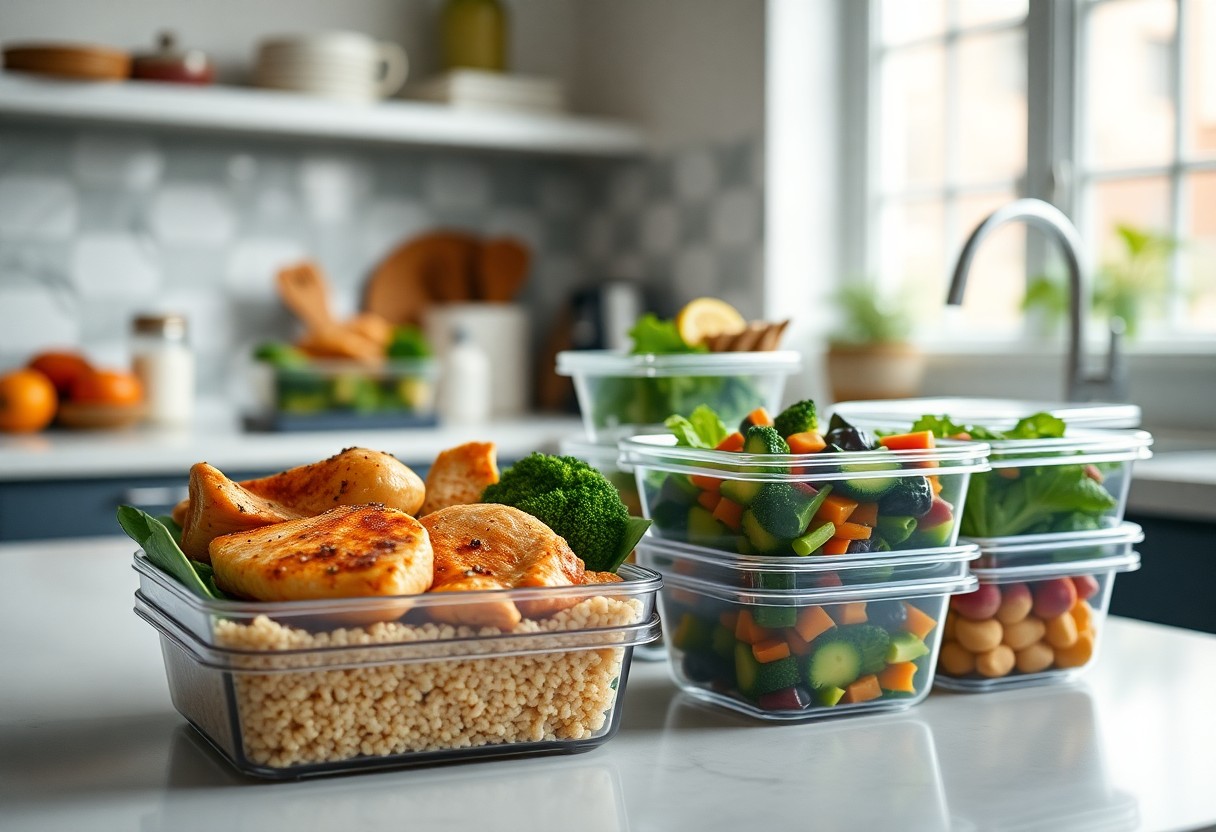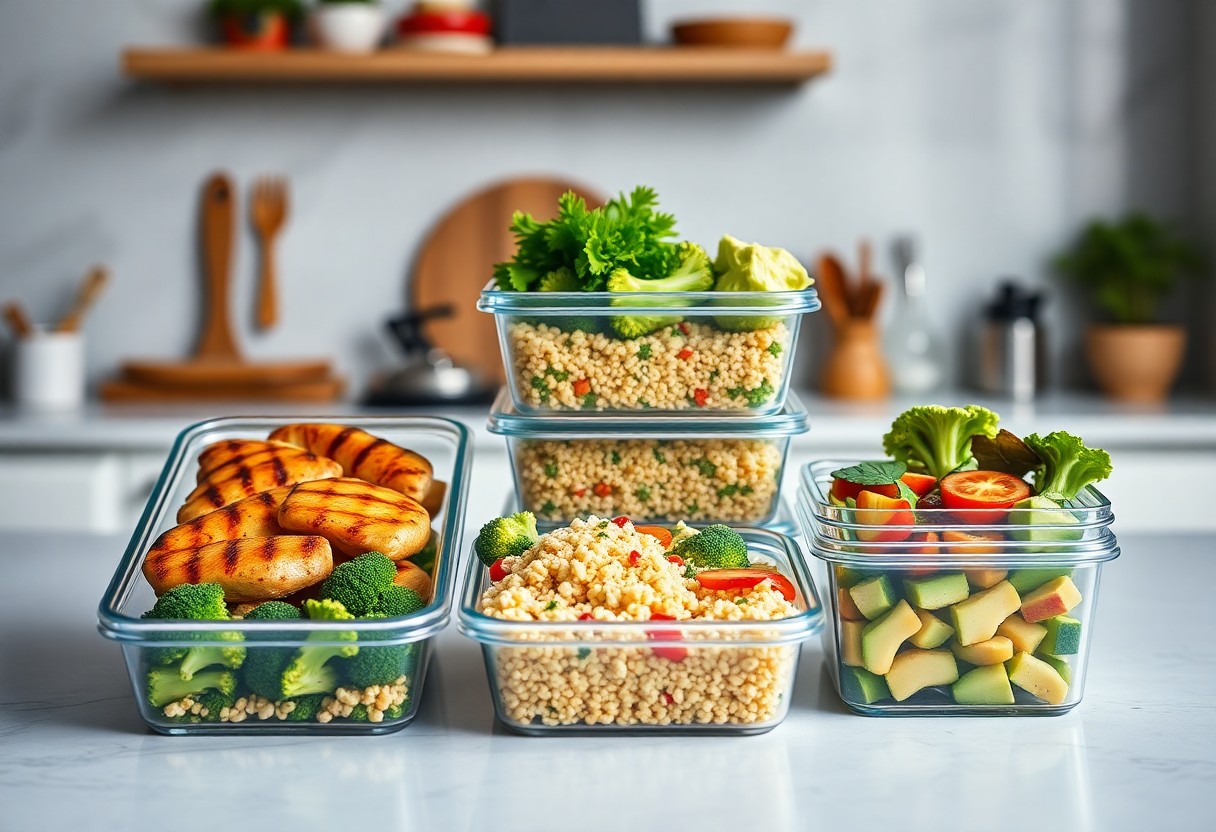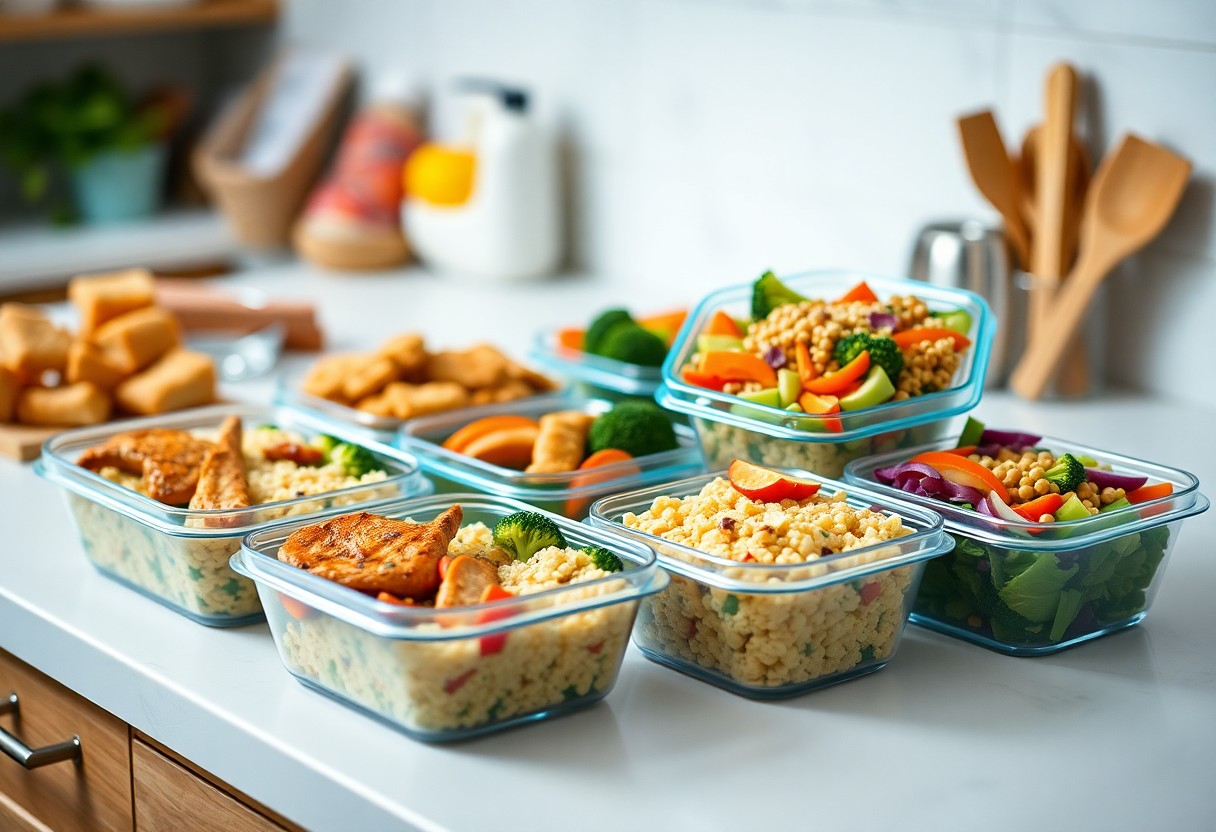Beginners often struggle to balance healthy eating with a busy work schedule, making it challenging to lose weight. However, by incorporating simple meal prep strategies, you can create delicious, nutritious meals that align with your weight loss goals. This guide will provide you with practical, easy-to-follow ideas that fit seamlessly into your routine, helping you maintain healthy eating habits without sacrificing your time or taste. Start your journey towards a healthier lifestyle with meal prep that makes your life easier and supports your weight loss efforts.
Key Takeaways:
- Plan Ahead: Setting aside time to plan your meals for the week can streamline your grocery shopping and cooking process.
- Batch Cooking: Preparing large quantities of meals at once can save time and ensure you have healthy options available throughout the week.
- Choose Balanced Recipes: Focus on meals that include a variety of food groups such as lean proteins, whole grains, and plenty of vegetables.
- Portion Control: Use containers to create appropriate portion sizes, helping you stick to your dietary goals without overeating.
- Stay Organized: Labeling your meals and organizing your fridge can make it easier to find healthy options in a busy week.
- Embrace Freezer-Friendly Options: Preparing meals that freeze well allows you to have ready-to-eat healthy options on hand for those particularly busy days.
- Incorporate Snacks: Prepare healthy snacks in advance to avoid unhealthy eating habits when you’re busy or on the go.
Understanding Meal Prep
A great strategy for healthy eating is meal prepping, which involves planning and preparing your meals in advance. This approach saves time during your busy week, reduces stress about what to eat, and helps you stick to your weight loss goals. By prepping your meals, you’ll have healthy, portion-controlled options ready when hunger strikes, preventing impulse eating and ensuring you remain on track with your dietary objectives.
Benefits of Meal Prepping
Prepping your meals can lead to significant health improvements by promoting balanced nutrition and portion control. It saves time during your hectic week and helps reduce the temptation to choose unhealthy takeout options. Moreover, having pre-portioned meals on hand allows you to better manage your calorie intake, ultimately making it easier to reach your weight loss goals.
Common Mistakes to Avoid
Mistakes in meal prepping can hinder your progress and make it more challenging to succeed. Often, beginners overlook portion sizes, leading to unintended overeating. Another common error is not planning for variety, resulting in menu fatigue. Additionally, using too many perishable ingredients can quickly lead to waste.
In fact, many people find themselves falling into the trap of restricting their meal options, causing them to feel deprived and ultimately abandon their meal prepping efforts. Other significant missteps include neglecting proper food storage techniques and failing to incorporate a mix of proteins, fats, and carbohydrates. Avoiding these pitfalls will not only enhance your meal prep experience but also support your weight loss journey effectively.

Planning Your Meals
Clearly, meal planning is an necessary step for anyone looking to lose weight while managing a busy work schedule. By taking a little time each week to outline your meals, you can avoid impulse eating and unhealthy choices. This approach ensures you have nutritious options ready when hunger strikes, making it easier to stay on track with your weight loss goals.
Setting Realistic Goals
Beside focusing on the meals themselves, it’s important to set realistic goals for your weight loss journey. Assess your current lifestyle, and consider what changes you can effectively implement without feeling overwhelmed. Aim for gradual progress rather than drastic changes to make your efforts sustainable.
Creating a Weekly Menu
Between your work commitments and personal life, a well-structured weekly menu can simplify your meal prep. This plan will not only save you time but also help you maintain a balanced diet. Make sure to include a variety of protein sources, vegetables, and whole grains to ensure you’re getting all the nutrients you need.
Consequently, creating a weekly menu allows you to streamline your shopping list and minimize food waste. Start by picking a day to sit down and list out healthy meals for the week. Consider incorporating simple recipes that can be made in bulk, which can then be divided into portions for quick grab-and-go options. By planning ahead, you increase your chances of sticking to your weight loss plan while also satisfying your taste buds.
Grocery Shopping Tips
Unlike a casual shopping trip, when grocery shopping for meal prep, it’s vital to have a game plan. Create a list to stay focused and avoid impulse buys. Here are some tips to keep in mind:
- Shop the perimeter of the store for fresh produce, proteins, and whole grains
- Buy items in bulk to save money
- Choose seasonal fruits and vegetables for better prices and freshness
- Always check for store sales or discounts
The right shopping strategy can set the foundation for your healthy eating journey.
Essential Ingredients for Healthy Meals
Healthy meal prep starts by stocking up on necessarys that keep things simple and nutritious. Focus on lean proteins like chicken, fish, and beans, a variety of colorful vegetables, whole grains like quinoa or brown rice, and healthy fats such as avocados or nuts. These ingredients will help you create balanced meals that satisfy your hunger while aiding in weight loss.
Budgeting for Meal Prep
Along with choosing the right ingredients, you also need to be mindful of your budget. Shopping with a clear budget will help you make smart choices without overspending.
Due to the rising cost of groceries, budgeting for meal prep is necessary for maintaining both your health and financial wellness. Start by planning your meals for the week and creating a shopping list to avoid unnecessary purchases. Look for discounts or coupons and consider flexible options like frozen fruits and vegetables, which can be cheaper and equally nutritious. By prioritizing healthy options and avoiding impulse buys, you can find an effective balance between nourishing your body and sticking to your financial goals.

Meal Prep Techniques
Your journey to healthier eating begins with effective meal prep techniques. By mastering these methods, you can save time during the week, keep your meals fresh, and stay on track with your weight loss goals. Two imperative techniques are batch cooking and proper portioning and storing, each playing a vital role in creating a sustainable meal prep routine that fits your busy lifestyle.
Batch Cooking
After selecting a few recipes, dedicate a day to batch cooking, where you prepare multiple servings of each dish. This not only simplifies your weekly meal prep but also allows flavors to deepen over time. Plus, cooking in larger quantities can save you both time and money, enabling you to focus on enjoying nourishing meals without the stress of daily cooking.
Portioning and Storing
Around the time you finish batch cooking, portioning and storing are imperative to keep your meals organized and easily accessible. Use airtight containers to separate your meals, ensuring you have the right amount for each serving. This organization helps monitor your calorie intake and prevents overeating, which can derail your weight loss efforts.
Indeed, portioning and storing your meals effectively not only maintains freshness but also promotes discipline in your eating habits. By using clear containers, you can track your portions more easily, minimizing the chance of consuming more than necessary. Labeling your meals with dates ensures that you consume them before they spoil, helping to reduce food waste and save money. Best of all, having ready-to-eat meals in your fridge or freezer can significantly cut down on the temptation of ordering unhealthy takeout, ultimately supporting your weight loss journey.
Quick Healthy Recipes
Now, you can whip up nutritious meals in no time by incorporating quick recipes into your meal prep routine. These straightforward dishes require minimal ingredients and preparation, making them perfect for your busy lifestyle. They not only save time but also help you stay on track with your weight loss goals without compromising on flavor.
Breakfast Ideas
Any morning can start off right with easy breakfast ideas like overnight oats, smoothie bowls, or egg muffins. These options are not only quick to prepare but packed with nutrients that fuel your day, setting a positive tone for your weight loss journey.
Lunch and Dinner Options
Among the best ways to maintain a healthy diet are simple lunch and dinner options such as grain bowls, stir-fries, and salads. These meals can be prepped in advance, allowing you to enjoy fresh ingredients and control your portion sizes.
Lunch can be as simple as assembling a quinoa bowl with diced vegetables and a lean protein, providing you with a balanced meal to sustain your energy. For dinner, consider a vegetable stir-fry that is quick to cook and bursts with flavor, while using healthy oils. Both options allow you to minimize extra calories from unhealthy condiments. Prioritize whole grains, lean proteins, and various vegetables to create satisfying meals that promote weight loss without sacrificing taste.

Staying Motivated
Many people find it challenging to stay motivated during their weight loss journey, especially when juggling a full-time job. To keep your spirits high, set small, achievable goals and celebrate your progress. Surround yourself with supportive friends or online communities and share your meal prep successes. Your dedication will pay off, both in weight loss and in establishing healthier habits.
Time Management for Meal Prep
One effective way to streamline your meal prep is to schedule dedicated time each week. By setting aside a couple of hours on weekends, you can prepare nutritious meals in bulk. Utilize simple recipes and make the most of appliances like slow cookers and instant pots, allowing you to focus on other tasks while your meals cook.
Overcoming Challenges
On your weight loss journey, you may encounter obstacles that test your resolve.
Staying committed to your goals means finding ways to tackle those challenges. If you face time constraints, consider batch-cooking on days off or prepping ingredients in advance. If cravings hit, have healthy snacks readily available to prevent you from reaching for unhealthy options. Also, it’s vital to cultivate a mindset of self-compassion; setbacks happen, but they don’t define your journey. Progress is about consistency, so focus on what works for you and don’t hesitate to adjust your plan as needed.
Final Words
Considering all points, healthy meal prep is an effective strategy for you to lose weight while managing a full-time job. By dedicating a few hours each week to plan and prepare nutritious meals, you can ensure that your diet supports your weight loss goals without the stress of last-minute decisions. Utilizing simple recipes, investing in quality storage containers, and incorporating a variety of foods can make your meal prep both enjoyable and sustainable. With the right approach, you can empower yourself to make healthier choices throughout your busy week.
FAQ
Q: What is meal prep and how can it help with weight loss?
A: Meal prep involves planning and preparing meals in advance, making it easier to stick to a healthy eating plan. For those trying to lose weight, meal prepping can help control portion sizes, reduce unhealthy snacking, and ensure that nutritious options are readily available, even on busy days.
Q: What are some easy meal prep ideas for beginners?
A: Beginners can start with simple recipes like grilled chicken with quinoa and steamed broccoli, overnight oats for breakfast, or vegetable stir-fries. Utilizing one-pot meals can make cooking and cleaning easier, while batch cooking grains and proteins can save time throughout the week.
Q: How can I keep my meals interesting during meal prep?
A: To keep meals exciting, try using different spices, herbs, or marinades to flavor your dishes. Incorporate a variety of vegetables and proteins, and experiment with different cooking methods such as roasting, sautéing, or grilling. Changing up the combinations and presentation can also enhance your experience.
Q: What containers should I use for meal prepping?
A: Investing in good-quality, BPA-free containers is vital for meal prepping. Look for containers that are microwave-safe, dishwasher-safe, and ideally come with airtight lids to keep food fresh. Glass containers tend to be more durable and easier to clean, while portion-sized containers can help with calorie control.
Q: How do I calculate the right portion sizes for my meals?
A: To determine appropriate portion sizes, consider using your palm as a guide for protein (about the size of your palm), fist for carbohydrates (about the size of your fist), and cupped hand for fats (about the size of your cupped hand). You can also consult with a nutritionist or use online balanced meal plate guidelines to tailor portions to your individual goals.
Q: Can I meal prep for someone with dietary restrictions?
A: Yes, meal prepping can be adapted to accommodate various dietary restrictions. Whether you have gluten-free, dairy-free, or vegetarian requirements, you can choose ingredients that fit your needs. Label containers clearly to prevent mix-ups, and ensure that recipes align with the individual’s dietary guidelines.
Q: How can I save time on meal prep while working full-time?
A: To save time, dedicate one day per week (such as Sunday) to cook and prep meals for the week ahead. During this time, chop vegetables, cook grains, and protein sources in bulk. You can also make use of kitchen appliances like slow cookers or Instant Pots to reduce active cooking time. Planning a simple, large batch recipe can cut down on overall effort, allowing for easier meals throughout the week.


